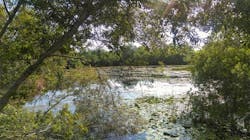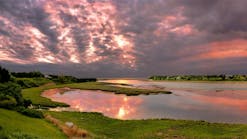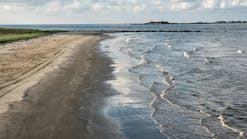It is possible to treat wastewater using free energy from nature, with no electricity, fossil fuels or chemical additives, and without the need for complicated mechanical devices. The power to clean water while saving energy is a key feature of constructed wetlands, and all too often, one of their most overlooked advantages.
Just like conventional WWTPs (Wastewater Treatment Plant), constructed wetlands can clean water using a process called aerobic/anaerobic cycling. However, while conventional WWTPs sustain this process using mechanical mixers, aerators and chemical additives, a constructed wetland uses energy from the sun, gravity, bacteria and plants. Since both technologies use the same process to clean water, a properly designed constructed wetland can clean water as well as a conventional WWTP but uses less energy.
How Do Constructed Wetlands Save Energy?
The low-energy treatment power of a constructed wetland comes from its design. Constructed wetlands are designed as retention basins with a fixed media, often sand or gravel. When wastewater enters a constructed wetland, it flows through the fixed media, which harbors populations of bacteria, who remove pollutants in the wastewater. If desired, wetland plants can also grow in the constructed wetland, extending their roots deep into the fixed media, nourishing the bacteria, and helping to remove pollutants. The result is a self-sustaining ecosystem that works the same as any ecosystem in nature but is engineered to target and resolve a particular wastewater problem. For this reason, constructed wetlands are an option for treating storm water but can address nearly any wastewater treatment scenario and can even treat challenging pollutants like heavy metals, hydrocarbons, pathogens and more. Since the constructed wetland’s own ecosystem does the hard work of removing pollutants, the machinery and chemicals used in conventional WWTPs are not needed. The constructed wetland’s ecosystem provides the energy all on its own.
Existing or graded site drainage is often all that is needed to convey wastewater into a constructed wetland and discharge treated effluent. But constructed wetlands can be equipped with pumps, if necessary. Pumps can be used to convey wastewater into the wetland or they can be used to recirculate water within a wetland, which improves treatment by a wide margin. However, even if an electric or fossil-fuel-powered pump is used, the energy requirements of a constructed wetland will still be far less than an equivalent conventional WWTP, for which aerators and mechanical mixers demand massive amounts of energy.
Saving Money with Wetlands
Saving energy with a constructed wetland also means saving money. According to a 2017 report by the U.S. Department of Energy, conventional WWTPs can spend up to 40% of their annual budget on electricity alone, collectively consuming over $2 billion of electricity per year nationwide. These facilities can also consume large amounts of fossil fuels.
By treating wastewater with a constructed wetland, these costs can be avoided. One American constructed wetland treats over 19 million gallons of combined sewer overflow per year, satisfying all water quality requirements without mechanical or electric parts, yet its annual energy budget is zero.
For large-scale constructed wetlands, the cost savings associated with energy can be astonishing. As proven by constructed wetland projects in the United States, Europe and Asia, highly contaminated industrial wastewater can be treated successfully using less than 5% of the energy required for a conventional WWTP, even at a large scale, millions or even billions of gallons per day. Engineers for one such constructed wetland estimated that a conventional WWTP would need 3,000 times more electricity to provide the same treatment. Another is expected to save its owners an estimated $282 million over 29 years when compared to a conventional WWTP. Clearly, constructed wetlands have an important role to play in providing low-energy wastewater treatment in a wide variety of contexts.
What About Climate?
Another benefit to the energy savings of constructed wetlands is their carbon footprint. It is not merely that constructed wetlands have a smaller carbon footprint: they can be carbon sinks. Plants growing in a constructed wetland tend to grow faster than they decompose, consuming carbon from the atmosphere faster than they contribute to it. Constructed wetlands also store organic matter in the media, just as a natural wetland would store organic matter in the soil, which increases carbon-sequestering power further.
Especially where no mechanical parts are being used, constructed wetlands have a high potential to act as carbon sinks that remove carbon from the atmosphere, with a far lower carbon footprint than what would be typical at a conventional WWTP. But even when constructed wetlands are designed with mechanical pumps, carbon emissions are far lower than what would be required for a conventional WWTP. Constructed wetlands are an excellent option when carbon foot printing and energy efficiency are top concerns.
A Way Forward
In a world of unpredictable prices and uncertain supply, energy may be an increasingly serious concern for communities and industries whose wastewater treatment relies on WWTPs alone. Citizens, industries, and governments around the world appear to value responsible stewardship of water resources, yet are ever more interested in energy efficiency, sustainability, and climate change as well. By providing reliable, resilient and effective wastewater treatment at a minimal energy cost, and by addressing concerns related to carbon emissions and climate change, constructed wetlands resolve many of the challenges that can be insurmountable for conventional WWTPs. Highly flexible and adaptable, constructed wetlands can supplement or replace conventional WWTPs and can be adapted to various wastewater management contexts, whether centralized or distributed: storm water, residential, municipal, combined sewer overflow, industrial and more. When energy is a concern, constructed wetlands are a viable option for wastewater treatment.
Landon Vine | Project scientist
Landon Vine is a project scientist with V3 Companies. Vine can be reached at [email protected].






